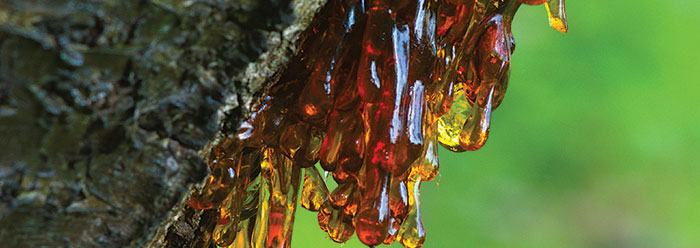Supposedly, dinosaurs lived during an “Age of Reptiles” when many of today’s creatures had not yet evolved. Museums and textbooks typically display fossil dinosaurs in isolation, and many modern paintings even depict dinosaurs alone except for a few ferns. Yet, secular researchers George Poinar, Jr. and Ron Buckley collected and studied fossils from Burmese amber, or Burmite, that hold evidence of a different history.1 This amber—hardened tree resin—preserved parts of modern-looking birds, reptiles, fish, clams, plants, and mammals in strata near or below dinosaur fossils. Should the Age of Reptiles be renamed for a more accurate description?
The evolutionary timescale maintains these amber fossils were deposited about 35 million years before the last surviving dinosaur died.1 If this is true, then the fossils should include numerous evolutionary precursors of contemporary plants and animals—but they don’t. Instead, the Burmite contains modern look-alikes, as well as extinct varieties.
Occurring near coal deposits, these remarkable specimens from Burma (present-day Myanmar) bear an assigned age of 100 million years.1 Apparently, a whole forest with damaged kauri trees—representatives of which grow and produce useful resins today—exuded copious amounts of resin years ago when their limbs and trunks were torn asunder. Soon after, water action separated the tree parts into layers and washed sediments between them. This aligns with a recent report on Burmite flowers, which stated that “the amber occurs in marine sedimentary rocks.”2 Such evident widespread watery violence clearly implies a massive flood event.
With further burial and heating, the tree bark turned into coal—a process that can be duplicated in a single day.3 The resin, situated separately but nearby, then hardened into amber—a process requiring weeks to decades, depending on factors like sample thickness, type of resin, and temperature.4
One unique Burmese amber nodule contains a mushroom fossil being eaten by a second fungus, which was being eaten in turn by a third fungus.5 They show that, just like today, ancient fungi parasitized other fungi. Some Burmite even contains fern and bamboo bits, indicating that a wide variety of flowers and grasses should be displayed in dinosaur dioramas.6,7
The Burmite fossil insects are spectacular and rare among ambers of the world. Several unfamiliar forms, like one unusually shaped type of fly, probably went extinct, but they represent basic kinds that still resemble extant varieties. Other familiar forms found in Burmite include a click beetle, weevil, moth, grasshopper, mayfly, caddisfly, lacewing, cockroach, bark beetle, walking stick, cicada, plant bug, bee, long horn beetle, ichneumonid wasp, gnat, midge, queen ant, praying mantis, and more. Some specimens also contain a centipede, millipede, jumping spider, tick, scorpion, many different garden spiders, a bark louse, leaf bits, nematodes, and a snail shell. The majority of these tiny entombed relics of the past look just like today’s versions.
Perhaps the most fascinating inclusions hint at larger creatures. One holds a small lizard’s foot, while another contains two flight feathers from a fully modern bird. This exposes the irrelevance of a 2011 report by the journal Science that claimed fibers from supposedly 65-million-year-old amber were dinosaur protofeathers. They could have been hairs or plant fibers.8 And some Burmite apparently does include hair.1 The supposed Age of Reptiles is quickly earning a description more like the “age of reptiles, mammals, birds, insects, and plants resembling modern varieties, plus a few that have since gone extinct.”
References
- Paleo Park. Posted on home.fuse.net/paleopark, accessed January 7, 2014.
- Poinar, Jr., G. O., K. L. Chambers, and J. Wunderlich. 2013. Micropetasos, a New Genus of Angiosperms from Mid-Cretaceous Burmese Amber. Journal of the Botanical Research Institute of Texas. 7 (2): 745-750.
- Hayatsu, R. et al. 1984. Artificial coalification study: Preparation and characterization of synthetic materials. Organic Geochemistry. 6: 463–471.
- Thomas, B. 2010. Amber Jewelry: A Conversation Piece for Creation Evidence. Acts & Facts. 39 (9): 17.
- Poinar, Jr., G. O. and R. Buckley. 2007. Evidence of mycoparasitism and hypermycoparasitism in Early Cretaceous amber. Mycological Research. 111 (4): 503-506.
- Poinar, Jr., G. O. 2004. Programinis burmitis gen. et sp. nov., and P. laminatus sp. nov., Early Cretaceous grass-like monocots in Burmese amber. Australian Systematic Botany. 17 (5): 497-504.
- Thomas, B. and T. Clarey. 2013. Pollen Fossils Warp Evolutionary Time. Acts & Facts. 42 (12): 14-15.
- Perkins, S. ‘Dinofuzz’ Found in Canadian Amber. ScienceNOW. Posted on news.sciencemag.org September 15, 2011, accessed January 7, 2014.
* Mr. Thomas is Science Writer at the Institute for Creation Research.










